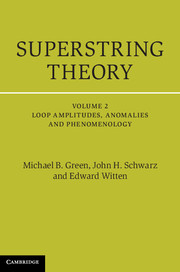Book contents
- Frontmatter
- Contents
- Preface to the 25th Anniversary Edition
- 8 One-loop diagrams in the bosonic string theory
- 9 One-loop diagrams in superstring theory
- 10 The gauge anomaly in type I superstring theory
- 11 Functional methods in the light-cone gauge
- 12 Some differential geometry
- 13 Low-energy effective action
- 14 Compactification of higher dimensions
- 15 Some algebraic geometry
- 16 Models of low-energy supersymmetry
- Bibliography
- References
- String Field Theory
- Index
10 - The gauge anomaly in type I superstring theory
Published online by Cambridge University Press: 05 September 2012
- Frontmatter
- Contents
- Preface to the 25th Anniversary Edition
- 8 One-loop diagrams in the bosonic string theory
- 9 One-loop diagrams in superstring theory
- 10 The gauge anomaly in type I superstring theory
- 11 Functional methods in the light-cone gauge
- 12 Some differential geometry
- 13 Low-energy effective action
- 14 Compactification of higher dimensions
- 15 Some algebraic geometry
- 16 Models of low-energy supersymmetry
- Bibliography
- References
- String Field Theory
- Index
Summary
The supersymmetric Yang-Mills multiplet in ten dimensions is parity violating; the massless fermions are spinors of SO(1,9) of one chirality or the other, but not both. In the context of string theory, this means that the massless fermion states of the open superstring have parity-violating gauge couplings. In fact, parity violation appears because there are two possible choices for the GSO projection in the Ramond sector, and one or the other must be chosen. Because of the role of the open superstring in constructing closed-string theories, most of the closed-string theories are likewise parity violating. For the type I and type IIB theories, the use of one GSO projection or the other introduces parity violation for closed strings just as it does for open strings. Parity violation is avoided in the type IIA theory, because one GSO projection is made for right-moving modes on the world sheet while the opposite GSO projection is made for left movers, and the overall system is invariant under simultaneous reflections or parity transformations of the world sheet and space-time. It is not invariant under separate world-sheet or space-time reflections. The heterotic theories are parity violating in the space-time sense (and on the world sheet), because a parity-violating right-moving multiplet is coupled to a parity-conserving left-moving multiplet.
Parity-violating gauge couplings of massless fermions are likewise conspicuous in four-dimensional physics; they are a basic part of the structure of the SU(2) × U(1) model of electroweak interactions.
- Type
- Chapter
- Information
- Superstring Theory25th Anniversary Edition, pp. 141 - 178Publisher: Cambridge University PressPrint publication year: 2012



